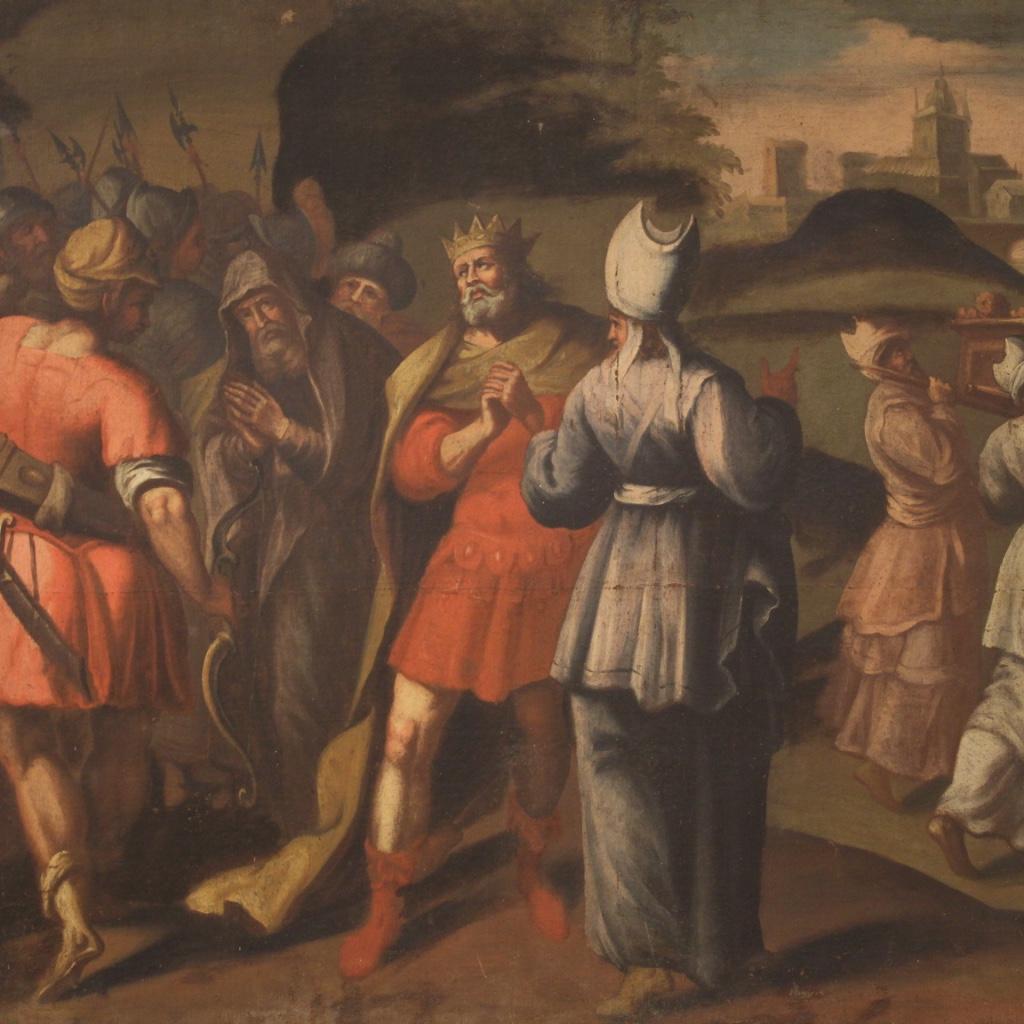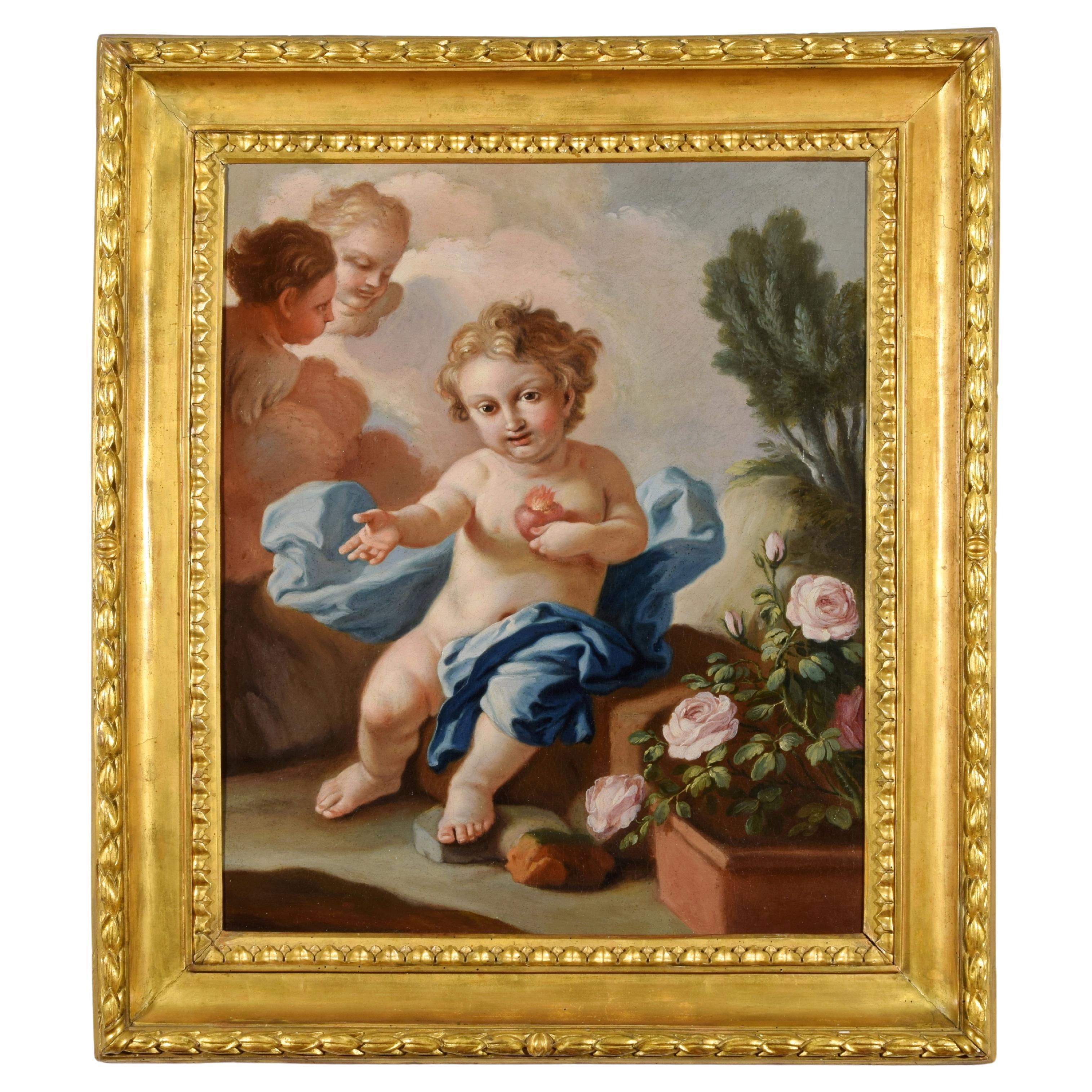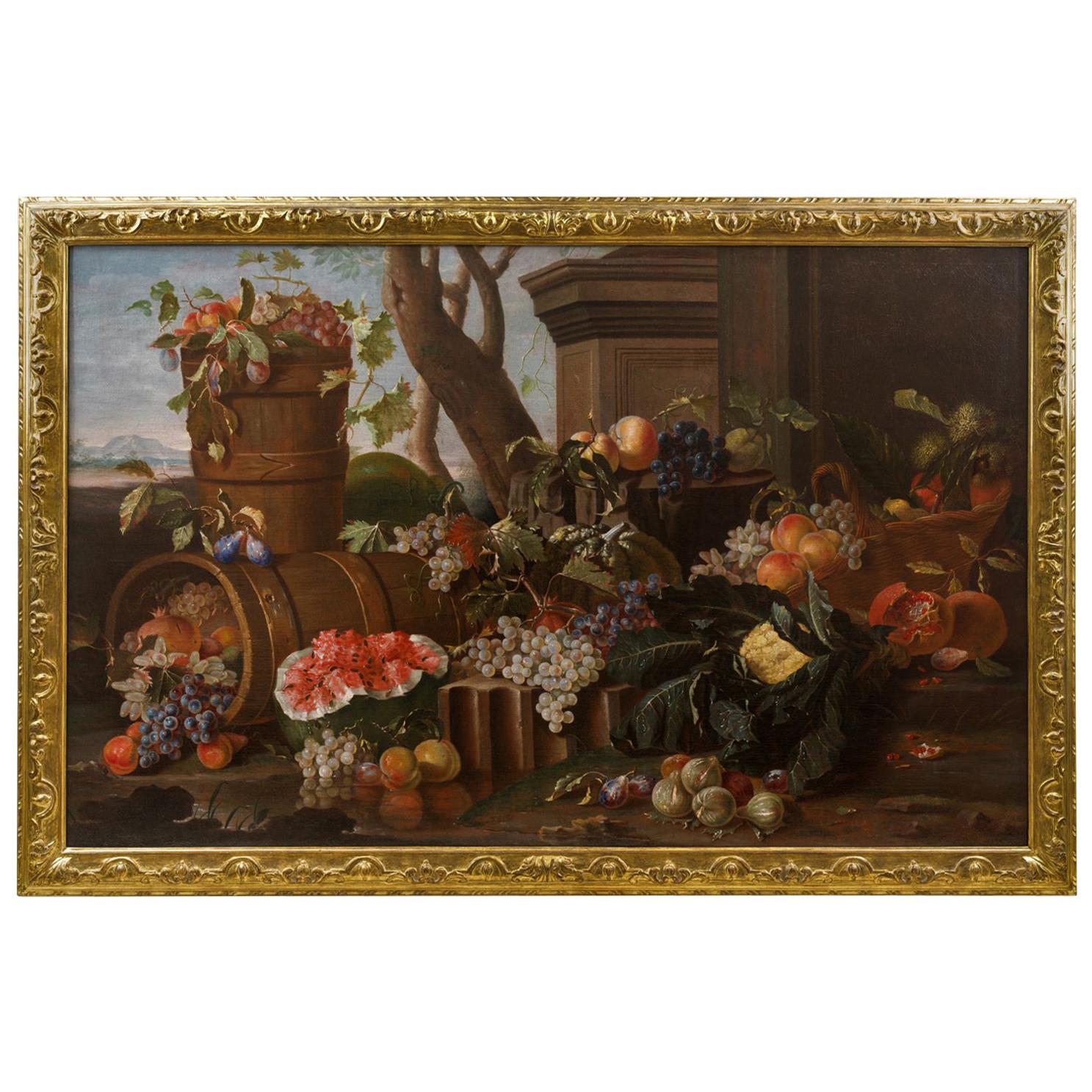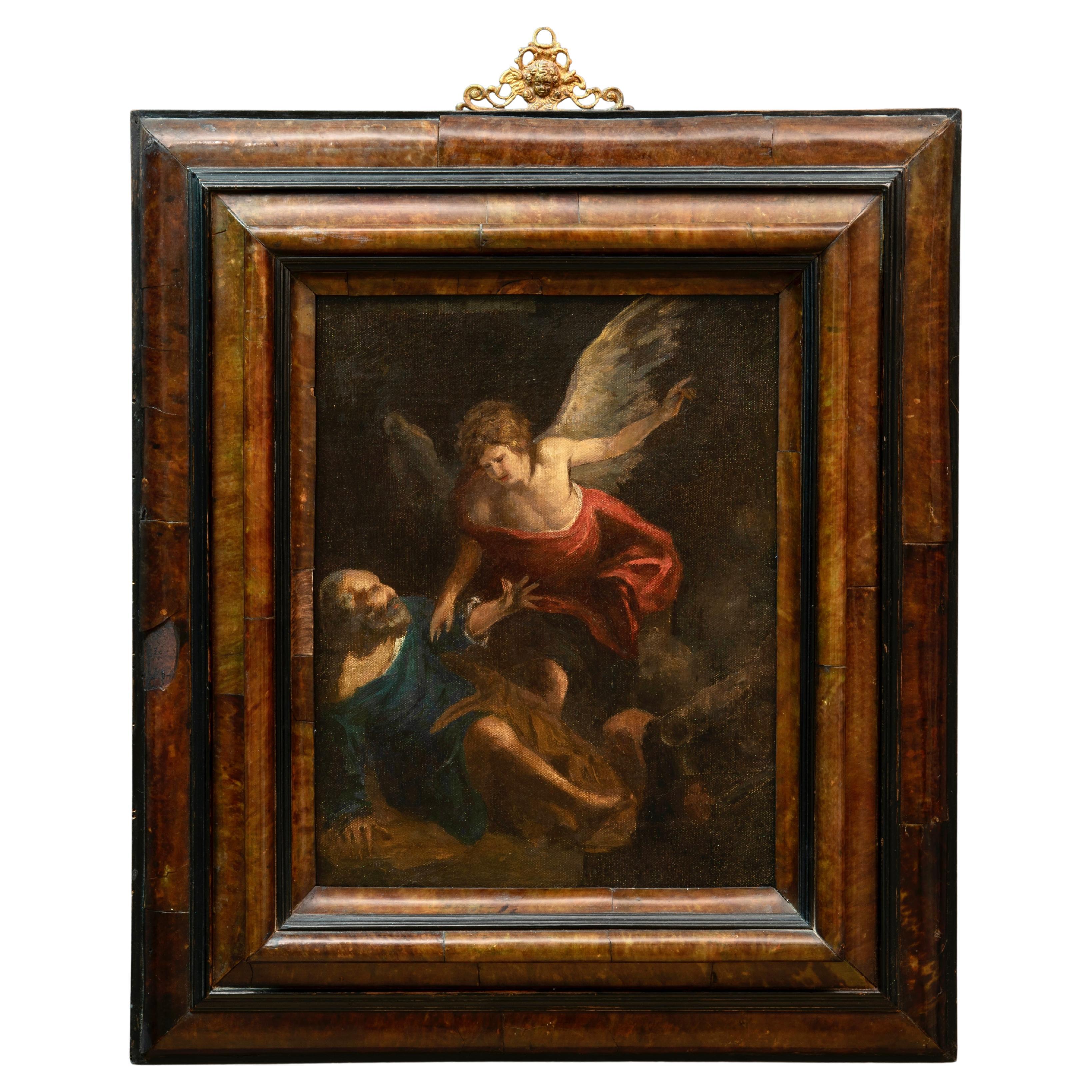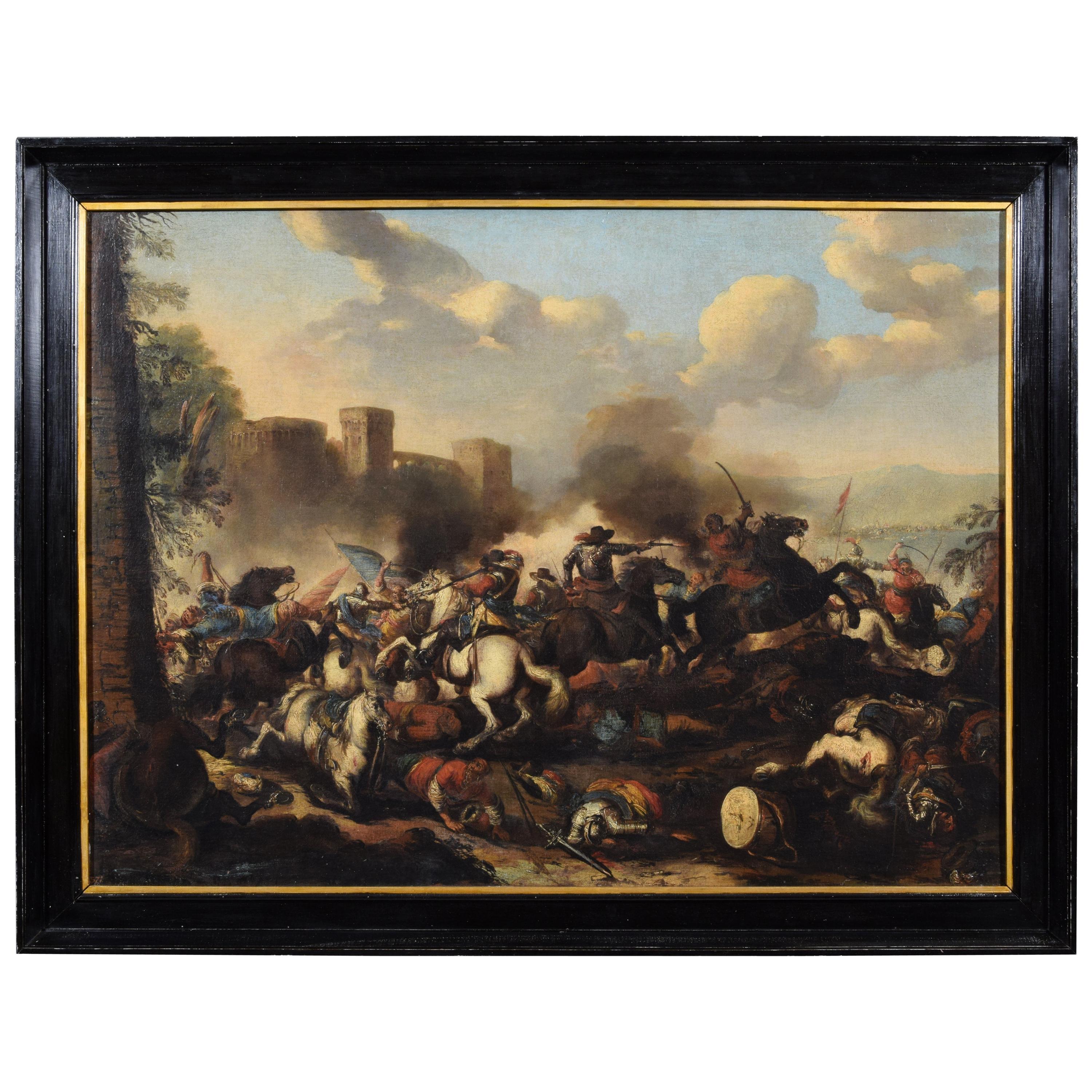Items Similar to 18th Century, Italian Oval Painting by Pietro D Ollivero with Historical Subject
Want more images or videos?
Request additional images or videos from the seller
1 of 11
18th Century, Italian Oval Painting by Pietro D Ollivero with Historical Subject
About the Item
Painting by Pietro Domenico Ollivero.
"Manio Annio Curio Dentato receives the ambassadors of the Samnites", around 1740
The work in question depicts the scene of and was made by the famous italian painter Pietro Domenico Ollivero. The oval canvas shows on the back the card of the Galleria Caretto in Turin (Italy) with the authentic 1965 Giorgio Caretto. The work was also published in "I Piaceri e le grazie" by Arabella Cifani and Franco Monetti in 1993.
The subject refers to the history of Rome and an episode narrated by the historian Valerio Massimo.
Manius Curius Dentatus (330 BC - 270 BC), one of the great Romans of the 3rd century B.C. was a consul in ancient Rome, known for ending the Samnite Wars. Elected consul in 290 BC. along with Publio Cornelio Rufino, in the same year he fought and won the Third War against the Samnites and their allies, thus ending a conflict that had lasted for 49 years. He definitively subdued the Sabines and the Greek army of Pyrrhus in the battle of Benevento. He represented the ideal prototype of ancient Roman for the generations that followed in that he avoided public honours; Cato the censor, who collected his sayings, placed him among the great figures of universal history. For centuries after his death (in 270 B.C. while overseeing the construction of the second aqueduct in Rome) his military exploits were recounted and his moral rectitude was praised as an example for all the Romans. Ollivero, in the cultured choice of the episode, illustrates the moment when Manio Curio Dentato is found in his home, characterized by Roman walls, sitting by the fire, on a rustic bench while eating his meal in a "ligneo catillo" (wooden basin). On the left came ambassadors who offered him money and other valuables. The rejection of the Roman hero came with the exclamation reported by Valerius Maximus: "narrated Sannitibus M. Curium malle locupletibus imperare quam ipsum fieri locupletem" (tell the Samnites that Manius Curius would rather reign over the rich than enrich himself).
Love of the little and poverty are characteristic elements of Ollivero’s life and of the choice of his subjects. The fact that he knew the work of Valerio Massimo confirms his articulated culture. The artist also represents the episode again with great vividness in a small picture, already on board and now on canvas, pendant with a "Sofonisba che beve il veleno". There are not many works known with historical subject of Pietro Domenico Ollivero; however, the present, dated to the forties of the eighteenth century, together with a few but significant other examples, demonstrate the ability of the author to touch even uncommon historical themes maintaining a great artistic quality, insinuating a new pictorial line in its vast panorama of subjects.
Pietro Domenico Ollivero (Turin, August 1, 1679 - Turin, January 13, 1755) is unanimously recognized as a master of Italian bambocciante painting of the first half of the eighteenth century. He is in fact responsible for a faithful image of the Turin society of the time thanks to his remarkable ability to outline with grace and humanity the crowds and places of the eighteenth-century subalpine capital, giving us a precious testimony of the Piedmontese civilization of his time. Born in Turin in 1679, his surname recurs in documents in several spellings. However, in the plots, drawings and holographic testament, the painter always signed Pietro Domenico Ollivero. In the 1705 census of Turin he was recorded as a cripple and in many drawings and paintings he portrayed his deformity with irony.
According to sources he was a pupil of the painter and architect Melchiorre Baldassarre Bianco and was strongly influenced by the Dutch and Flemish painters active in Turin in the second half of the seventeenth century: Melchior Hamers, Peter Mauritz Bolckman, Abraham Godyn, Jean-Baptiste Abret, Jean Miel. He was protected by King Vittorio Amedeo II of Savoy; however, to the more conventional themes proposed by the illustrious patron, Ollivero preferred to portray streets and squares of his city, studying above all the social characteristics of the lower classes. He was much appreciated by the Savoy nobility and by the court that provided him with continuous commissions until his last years of life.
Among the most important commissions is Pietro Mellarède, Minister of the Interior of Vittorio Amedeo II, who owned 15 of his paintings, climbed between 1698 and the eighteenth century, still preserved in the castle of Betton Bettonnet in Savoy. In 1711 he had a workshop already started and works for the Venaria Reale (1714) and the royal palace of Turin (1716) are documented. In 1717 he appeared for the first time among the brothers of the Confraternita dei Ss. Maurizio e Lazzaro of Turin, of whom he was collaborator, councillor emeritus and benefactor until his death. In 1726 he was elected prior of the Accademia di san Luca of Turin. In these years of full maturity, he was favored by the support of the first court painter Claudio Francesco Beaumont and the powerful minister Carlo Vincenzo Ferrero di Roasio Marchese d'Ormea who commissioned dozens of paintings for the residences of Cavoretto, Turin and Montaldo Torinese. He worked for the Agliè and Guarese castles of Agliè (1737), for the royal palace of Turin, for the hunting palace of Stupinigi. Of 1743 are the Notturno con il falò di S. Giovanni Battista a Torino and a Processione alla Madonna del Pilone (both preserved in the Civic Museum of Ancient Art in Turin). In 1745 and 1746 he dedicated himself to the design of sets for the Regio theatre in Turin; he also provided drawings of genre scenes and battles to the cabinetmaker Luigi Prinotto and other cabinetmakers of the early 18th century in Turin. They recall, in particular, the works for the hunting palace di Stupinigi, for which he executed, from 1748 to May 1753, at least thirty paintings, in part intended to overlap. On 15 November 1754 he signed the will. He died in Turin on 13 January 1755 and was buried, at his disposal, in the basilica Mauriziana.
Please contact us to have the expertise of the painting, in Italian.
- Dimensions:Height: 25.6 in (65 cm)Width: 20.48 in (52 cm)Depth: 0.79 in (2 cm)
- Style:Baroque (Of the Period)
- Materials and Techniques:
- Place of Origin:
- Period:1740-1749
- Date of Manufacture:1740
- Condition:Refinished.
- Seller Location:IT
- Reference Number:1stDibs: LU4405232759332
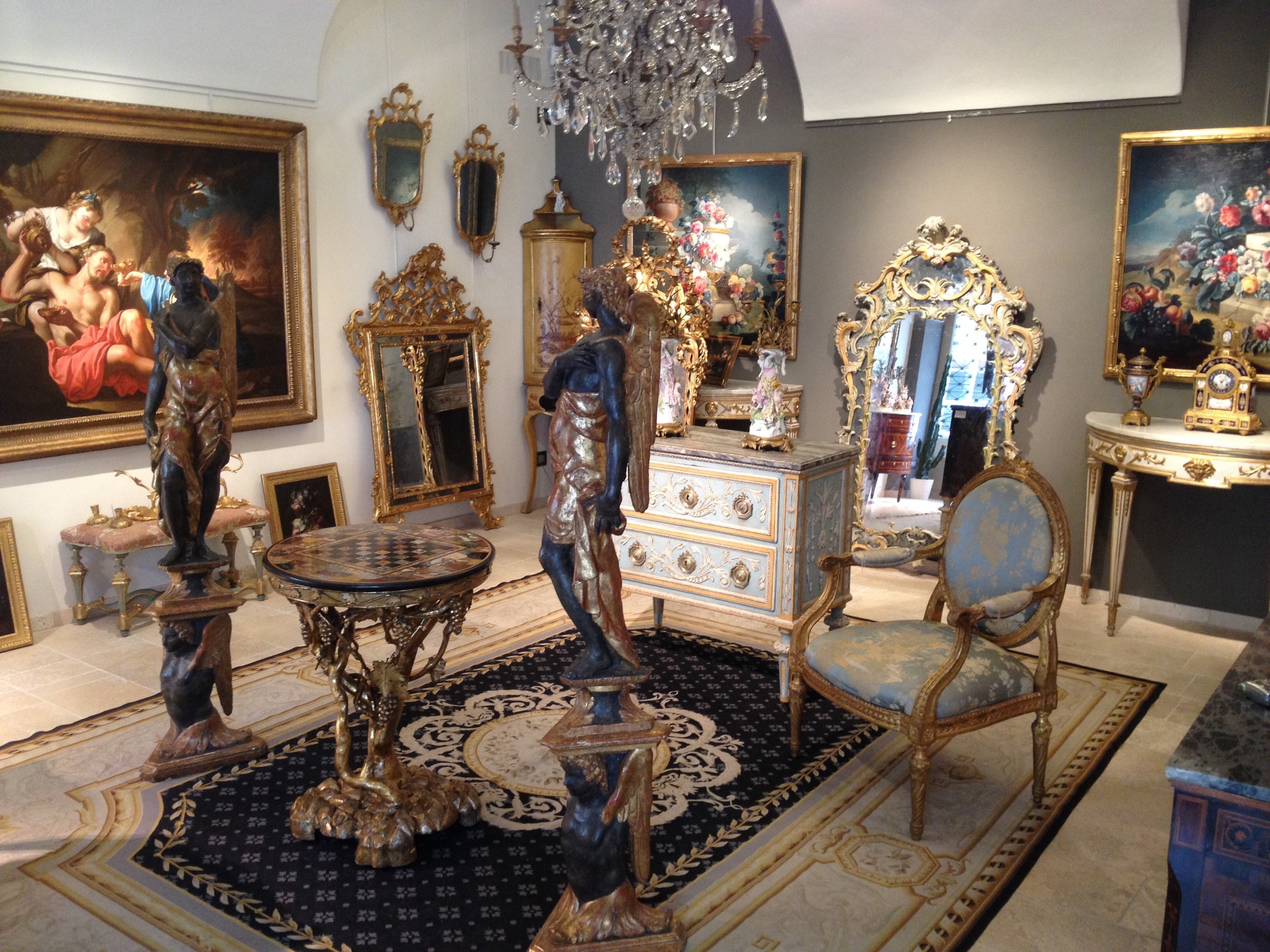
About the Seller
5.0
Gold Seller
These expertly vetted sellers are highly rated and consistently exceed customer expectations.
Established in 1980
1stDibs seller since 2019
40 sales on 1stDibs
Typical response time: 1 hour
- ShippingRetrieving quote...Ships From: Italy
- Return PolicyA return for this item may be initiated within 7 days of delivery.
More From This SellerView All
- 18th Century, Italian painting with Sacred Heart of the Child Jesus by Pietro BaBy Pietro BardellinoLocated in ITPietro Bardellino (Italy - Naples, 1732 - 1806), attr., Sacred Heart of the Child Jesus Measurements: with frame, cm L 86 x H 99 x P 8; only the canvas, cm L 78 x H 64 The pain...Category
Antique Mid-18th Century Italian Baroque Paintings
MaterialsCanvas
- 18th Century, Italian Oil on Canvas Still Life by Pietro NavarraLocated in IT18th century, Italian oil on canvas still life by Pietro Navarra Oil on canvas, canvas measures: cm H 103 x W 164, framed measures...Category
Antique 18th Century Italian Baroque Paintings
MaterialsCanvas
- 18th Century Italian Oil on Canvas Painting with Battle by Antonio CalzaBy Antonio CalzaLocated in ITAntonio Calza (Italy, Verona, 1653-18th April 1725) "Battle between Christian and Turkish cavalry with castle" The painting depicts a bloody battle between Christian and Turkish cavalry. Characterized by dynamism, intensity of color and light, the main scene occupies the lower horizontal section of the canvas, optically interrupted by the black fumes of the shots from which emerge, on the left, the towers of a fortress. On the right, in the distance you can see the combat in progress in the countryside, beyond which you can see the pale presence of hills that create a fifth, marking the horizon. To frame the scene contributes to the left, against light and in the foreground, a portion of the wall. The painter, however, introduces a horse on the ground, of which we see only the back, a ruse to involve the observer making him become active and participate in the scene. In the foreground, lifeless bodies, wounded horses and, scattered on the ground, weapons and a drum enhance the drama of the clash. The excitement and expressive force, the intense chromatic range attentive to the conditions of light and the fine brushstrokes, decisive and dramatic, suggests the attribution to Antonio Calza, one of the most important painters of battles of the seventeenth century, excellent student and continuator of the greatest interpreter of the genre, Jacques Courtois called il Borgognone (Saint-Hyppolite 1621 - Rome 1676). Il Borgognone, although not having had a real school or direct students, places itself as a primary reference point by the Italian and foreign "battaglisti". The genre of battle painting found great success in the collections of the Italian and European nobility of the seventeenth and eighteenth centuries. The battles of the Italian Renaissance, in which the scene converged towards a precise protagonist, evolve towards a type of combat "without hero". The bloody realism of the details and the dynamic development of the narrative confuse the figure of the protagonist, when present, to give importance to the swirl of horses and armed fighters, among which, moreover, does not emerge a winner. The certain documents relating to the life and movements of Antonio Calza are scarce; it was equally difficult to reconstruct, from the critics, a catalogue of autograph works. Through paintings in private collections, in museums and paintings passed on the antiques market it has been possible to identify a copious corpus of works that can be traced back to his hand. The work of art historians, together with that of antique dealers, in conferring proper attributions in order to best outline the figure of Calza, continues but studies are still in progress. In this sense, the work of Giancarlo Sestieri should certainly be noted, who investigated the artistic production of the battaglisti and Calza, thus allowing the comparison of the numerous photographic works reported, to identify and recognize the stylistic qualities that distinguish the corpus of paintings assigned to him today. Antonio Calza was born in 1653 in Italy, in Verona and in 1664 he entered the school of Carlo Cignani in Bologna, dedicating himself to painting battles and landscapes. He then perfected in Rome, where he knew the works of the then undisputed head of the sector, Jacques Courtois called the Burgundian. In 1675 he returned to Verona and married an 88-year-old widow who, dying, left him a rich inheritance. Much appreciated by the nobility and the bourgeoisie, he received numerous commissions. Bartolomeo Dal Pozzo (Le Vite de' pittori, de gli scultori et architetti veronesi, 1718) praises "three great paintings of battles...Category
Antique Late 17th Century Italian Baroque Paintings
MaterialsCanvas
- 18th Century, Italian Oil on Canvas Painting with Landscape with RuinsLocated in IT18th century, Italian oil on canvas painting with landscape with ruins Measures: only the canvas cm W 97.5 x H 108; with the frame cm W 103.5 x H 114 x D 5 The fine oil on canv...Category
Antique 18th Century Italian Baroque Paintings
MaterialsCanvas
- 18th Century, Italian painting Depicts Bambocciata by Giovanni Michele GraneriLocated in ITGiovanni Michele Graneri (Italy, Turin 1708-1762) Bambocciata (Farmers dancing in front of the inn) The painting, made in oil on canvas, depicts a moment of celebration where some p...Category
Antique Mid-18th Century Italian Baroque Paintings
MaterialsCanvas
- 18th Century, Painting with Still Life by Maximilian PfeilerLocated in ITMaximilian Pfeiler (active Rome, circa 1694-circa 1721 Budapest) Still life with peaches, grapes, figs and pomegranate Oil on canvas, Measures: cm H 63,5 x W 47. With frame cm ...Category
Antique Early 18th Century Italian Baroque Paintings
MaterialsCanvas, Wood
You May Also Like
- 18th Century Oil on Canvas Italian Painting Historical / Biblical Subject, 1720Located in Vicoforte, PiedmontAncient Italian painting from the first half of the 18th century. Oil on canvas framework, first canvas, depicting historical/biblical subject, King David brings the ark of the coven...Category
Antique 1720s Italian Paintings
MaterialsCanvas
- 18th Century Italian PaintingLocated in San Francisco, CACharming old Italian village scene of a young girl with her cow and sheep. Oil on canvas in giltwood frame. The painting without the frame measures 19 3/4" high x 22 3/4" wide. Italy...Category
Antique 18th Century Italian Paintings
MaterialsCanvas
- Pietro Novelli 17th Century Italian Religious PaintingBy Pietro NovelliLocated in Roma, ITImportant oil on canvas painting depicting Saint Peter in prison being freed by the Angel. The original is kept at the Regional Gallery of Palazzo Abatellis in Palermo. It comes fro...Category
Antique 17th Century Italian Baroque Paintings
MaterialsBronze
- 18th Century Convivial Scene Painting Oil on Canvas by Pietro FabrisLocated in Milan, ITAttr. to Pietro Fabris (active in Naples, 1756 - 1792) Convivial scene Oil on canvas, 63 X 75 cm The canvas in question depicts a joyful banquet scene with characters dressed in traditional clothes typical of southern Italy, similar to Pietro Fabris. Much biographical information is lacking on this painter who was active in Naples between 1756 and 1792. It is assumed that he was of English origin, since he himself in many paintings is signed, next to his name, "English painter". Also appreciated in England, Fabris in 1768 exhibited in London at the Free Society and in 1772 at the Society of Artist. His vast known artistic production must therefore be included between the date of 1756, affixed to a Neapolitan scene (London, Trafalgar Galleries: see Spinosa, 1987, p. 162), and that of 1792, execution of the Pilgrimage to the sanctuary of the Madonna dell 'Arco (antiques market, formerly Matthiesen, London, published in Spinosa, 1987, fig. 410). This production includes numerous oils on canvas, gouaches and drawings, inspired by Neapolitan views and landscapes and popular scenes, festivals and costumes of southern Italy. In the initial phase, references to Carlo Bonavia and Gabriele Ricciardelli are marked, later enriched by collusions with the scenographic landscape painting of Antonio Joli...Category
Antique 18th Century Italian Paintings
MaterialsCanvas
- Painting Lake Garda Italian School 18th CenturyLocated in Lisbon, PTA grand view of an Italian lake, tower with the lake Garda (other name Benaco) and boats in the background. An Italian School from XVIII Century. Frame with glass. Frame: Width: ...Category
Antique 18th Century Italian Baroque Paintings
MaterialsWood, Paper
- A late 18th Century Italian PaintingLocated in Hudson, NYThis lovely and decorative painting of peasants in a bucolic setting with numerous farm animals is typical of the period and is designed to illustrate happier moments and a getting b...Category
Antique Late 18th Century Italian Paintings
MaterialsCanvas, Wood
Recently Viewed
View AllMore Ways To Browse
Italian Baroque Canvas
Nobility Painting
Painting Greek Roman
Wall Fire Place
S Giorgios
Italy Battle Painting
Antique Curio
Antique Curios
Curio Antique
Antique Curio Furniture
Wooden Castle
18th C Italian Painting
Antique Sayings
Baroque Board
Greek Capital
Painted Wooden Benches
Painted Wooden Bench
Bench Wooden Back
